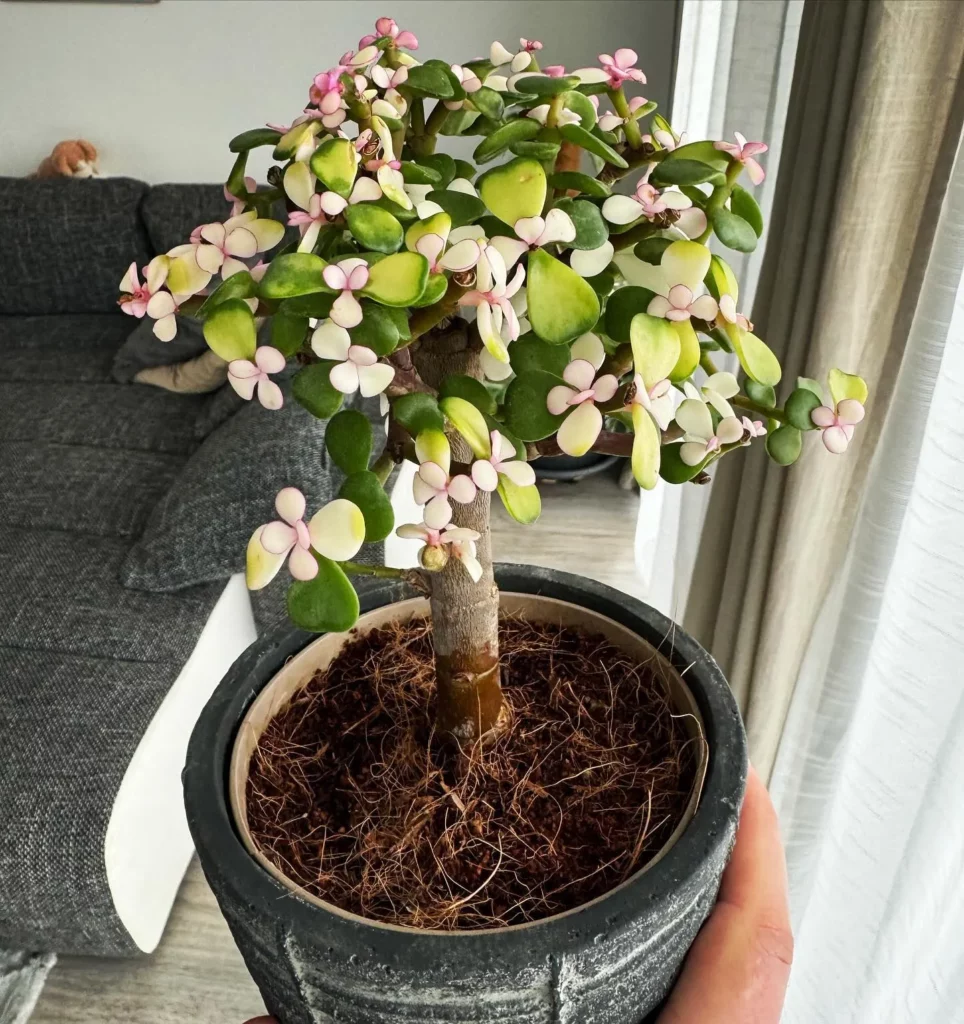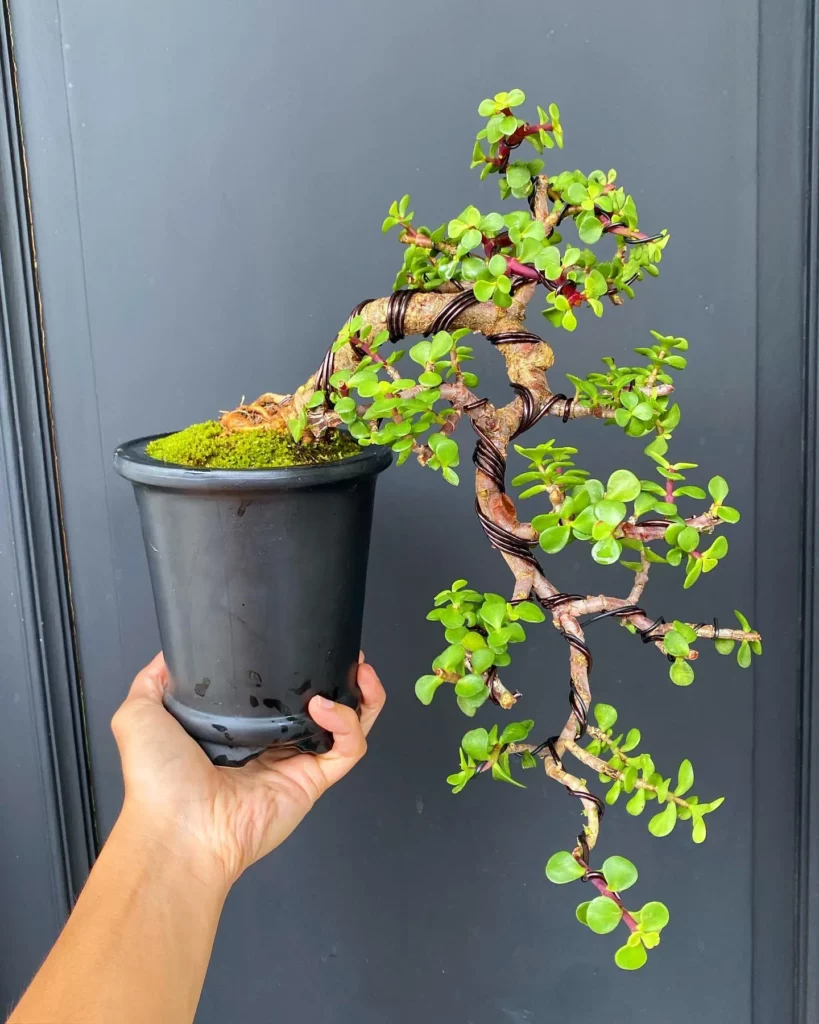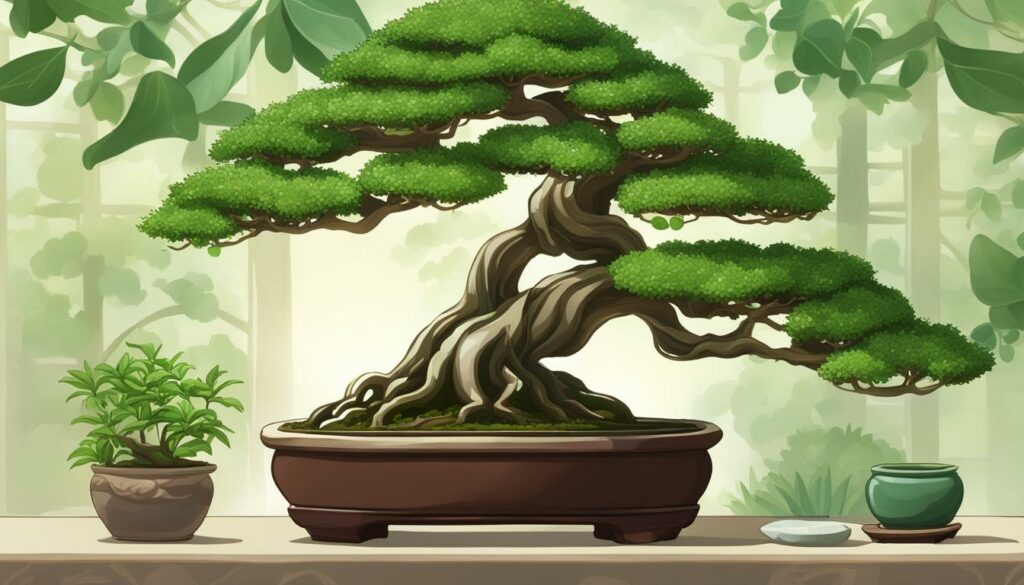Jade plants are known for their unique and striking appearance. With their thick, woody stems and fleshy, oval-shaped leaves, these plants make a beautiful addition to any indoor or outdoor space. Jade plants can reach a total height between three and six feet, making them a substantial presence in your home or garden.
Make sure to check out our Jade Bonsai article next.
Key Takeaways:
- Proper care is essential for the longevity of jade plants
- Jade plants require indirect sun outside and full sun indoors
- Be cautious not to overwater as jade plants store water in their leaves and stems
Appearance of Jade Plants



What sets jade plants apart is the variety of leaf colors and shapes they offer. There are different cultivars to choose from, each with its own distinct features. For example, the “Bronze Beauty” variety has small coppery/green leaves, while the “California Red Tip” showcases foliage tinged with purple or red. If you prefer a more unique look, the “Gollum” variety has tubular-shaped, finger-like leaves, while the “Hobbit” has smaller curled leaves.
If you’re looking for a splash of color, the “Sunset” variety boasts variegated green leaves, while the “Tricolor” variety delights with pointed leaves of creamy white and rose-striated foliage. The “Variegata” variety stands out with its bicolor leaves of cream and green. With so many options, you can find a jade plant that fits your aesthetic preferences.
Jade Plant Light Requirements



When it comes to the light requirements for jade plants, it’s important to provide them with the right amount of sun exposure. These plants thrive in dry, sunny areas in their native region, so they require at least six hours of bright indirect sunlight per day. If you’re growing jade plants indoors, it’s best to place them in a south-facing window where they can receive ample sunlight. However, it’s important to gradually introduce them to direct sunlight to avoid leaf burn.
No products found.
Indoor Lighting for Jade Plants
If you’re unable to provide enough natural light for your jade plants indoors, you can supplement their lighting with artificial sources. LED grow lights are a popular choice as they provide the necessary spectrum of light for plant growth. When using grow lights, it’s important to position them at the proper distance from the plants to avoid damage. Keep the lights about 12-18 inches above the top of the plants and adjust the height as the plants grow.
It’s worth noting that the development of a red tint along the edges of the leaves indicates that the jade plant is receiving sufficient light. If the plant starts to stretch or becomes leggy, it’s a sign that it’s not getting enough light. On the other hand, if the leaves turn yellow and begin to drop, it may be a sign of excessive light exposure or heat stress. Finding the right balance of light is crucial for the health and growth of your jade plants.
- Jade plants require at least six hours of bright indirect sunlight per day.
- Place indoor jade plants in a south-facing window gradually introducing them to direct sunlight.
- Supplement indoor lighting with LED grow lights positioned 12-18 inches above the plants.
- A red tint along the edges of the leaves indicates sufficient light, while stretching or yellowing leaves may indicate inadequate or excessive light exposure.
Watering Jade Plants



Proper watering is crucial for the health and longevity of jade plants. These succulent plants have thick, fleshy leaves that store water, allowing them to tolerate periods of drought. However, overwatering can lead to root rot and other issues, so it’s important to follow the correct watering practices.
Watering Frequency
- During the growing season, typically from spring to late autumn, jade plants should be watered when the top inch of the soil has dried out.
- A good way to determine if it’s time to water is by sticking your finger into the soil. If it feels dry at the depth of your first knuckle, it’s time to water.
- Avoid watering on a set schedule, as the frequency may vary depending on factors such as temperature, humidity, and the size of the pot.
Watering Technique
- When watering jade plants, it’s best to use the “soak and dry” method.
- Thoroughly water the soil until it’s evenly moist, allowing any excess water to drain out through the drainage holes in the bottom of the pot.
- Avoid leaving the plant sitting in a saucer of water, as this can lead to root rot.
Signs of Overwatering and Underwatering
- If jade plants are overwatered, the leaves may become yellow, mushy, or fall off the plant easily.
- On the other hand, underwatered jade plants may have shriveled, wrinkled leaves and may become droopy.
- Observing the plant and adjusting your watering habits accordingly will help maintain the ideal moisture balance for your jade plant.
Jade Plant Fertilizing: Tips for Healthy Growth



Fertilizing jade plants is an essential part of their care routine, ensuring they receive the nutrients they need for healthy growth. Here are some key points to keep in mind when it comes to fertilizing your jade plant:
- Fertilizing Frequency: Jade plants should be fertilized every other month to every two months during their active growing season, which typically spans from spring to late autumn. This regular fertilization helps provide the necessary nutrients for robust foliage and vibrant growth.
- Types of Fertilizer: When choosing a fertilizer for your jade plant, opt for a balanced water-soluble fertilizer. A flowering houseplant fertilizer is a great choice, as it contains the essential macronutrients your plant needs, including nitrogen, phosphorus, and potassium.
- Application Method: It’s important to avoid applying fertilizer to dry soil, as this can potentially damage the roots of your jade plant. Instead, water your plant as you normally would, and then immediately follow up with the diluted fertilizer solution. This helps ensure that the nutrients are properly absorbed by the roots.
- Newly Repotted Plants: If you have recently repotted your jade plant, it’s best to wait for about four months before applying any fertilizer. This allows the plant to acclimate to its new pot and establish its root system before introducing additional nutrients.
- Observing Plant Response: Keep an eye on your jade plant’s response to the fertilizer. If the leaves start to turn yellow or show signs of burning, it’s a sign that you may be over-fertilizing. In such cases, it’s recommended to flush the soil with water to help remove any excess nutrients.
Potting Jade Plants



When it comes to potting jade plants, choosing the right container is crucial for their growth and stability. Sturdy clay or ceramic pots are ideal options as they provide good drainage and prevent the plants from becoming top-heavy. The size of the pot should be proportionate to the size of the plant, allowing enough room for root growth.
Repotting jade plants is recommended every 2-3 years to prevent them from becoming root-bound. The best time to repot is during the plant’s growing season, when new growth is evident. During the repotting process, you can prune the roots if you’re using the same size pot, and cut back the stems to encourage trunk development. It’s important to limit watering for newly repotted jade plants until they become established in their new container.
To ensure successful potting, use well-draining soil specifically formulated for succulents or cacti. This type of soil allows excess water to flow through, reducing the risk of root rot. Remember to place a layer of small rocks or broken pottery at the bottom of the pot to further enhance drainage.
- Choose sturdy clay or ceramic pots for potting jade plants to ensure stability.
- Repot jade plants every 2-3 years during their growing season to prevent root-bound growth.
- Prune roots and cut back stems during repotting to promote healthy growth.
- Use well-draining soil formulated for succulents or cacti to prevent root rot.
- Add a layer of rocks or broken pottery at the bottom of the pot to enhance drainage.
Propagation of Jade Plants


If you’re a plant lover like me, you’ll be delighted to learn that jade plants are incredibly easy to propagate. Whether you want to expand your collection or share the beauty of these plants with others, propagating jade plants is a fun and rewarding process. There are two popular methods for propagating jade plants: stem cuttings and leaf cuttings.
Stem Cuttings
- Select a healthy, mature stem from your jade plant.
- Using a clean, sharp knife or pruning shears, cut a 4 to 6-inch section of the stem.
- Allow the cut end to dry and callous over for a few days.
- Once calloused, place the stem cutting in a well-draining potting mix.
- Water the cutting lightly and place it in a warm, bright location, but avoid direct sunlight.
- Within a couple of weeks, roots should begin to develop, and you’ll have a new jade plant.
Leaf Cuttings
- Select a healthy, plump leaf from your jade plant.
- Gently twist the leaf from the stem, ensuring you have the entire leaf intact.
- Allow the cut end of the leaf to dry and callous over for a few days.
- Place the leaf on top of a well-draining potting soil mix, making sure it makes contact with the soil.
- Mist the leaf occasionally to keep it barely moist.
- Over time, roots will begin to emerge from the leaf, and tiny baby plants will grow along the edges.
Growth and Development of Jade Plants
As jade plants grow, they undergo several stages of development, each marked by unique characteristics. Understanding these growth stages can help you better care for your jade plant and anticipate its needs.
1. Seedling Stage
During the seedling stage, jade plants start as tiny sprouts emerging from the soil. This stage is crucial for establishing a strong foundation for future growth. Seedlings require consistent moisture and indirect sunlight to thrive. To ensure their success, keep the soil lightly moist and provide them with bright, filtered light.
2. Juvenile Stage
As jade plants mature, they enter the juvenile stage, characterized by the development of thick, woody stems and plump, green leaves. At this stage, their growth accelerates, and they start to take on the iconic appearance of a jade plant. Adequate sunlight, well-draining soil, and occasional fertilization are essential for healthy juvenile jade plants.
3. Adult Stage
Once jade plants reach maturity, they enter the adult stage, where their growth rate slows down. In this stage, jade plants develop into sturdy, tree-like structures with thick trunks and glossy, succulent leaves. They can reach heights of three to six feet, becoming a stunning centerpiece in any space. Careful maintenance, including proper watering, sunlight exposure, and occasional pruning, will help ensure the long-term health and beauty of your mature jade plant.
Pests and Diseases of Jade Plants
When caring for jade plants, it’s important to be aware of the potential pests and diseases that can affect them. These common problems can impact the health and appearance of your jade plant, but with proper attention, they can be managed effectively.
One of the most common pests for jade plants is mealybugs. These tiny insects can infest the leaves and stems, sucking out the plant’s sap and causing damage. To combat mealybugs, simply take an alcohol swab and gently wipe them away. Regularly inspect your jade plant to catch any infestations early.
Jade plants can also be susceptible to powdery mildew, a fungal disease that leaves a white powdery coating on the leaves. To treat powdery mildew, you can use a horticultural oil, applying it according to the product’s instructions. It’s important to treat powdery mildew as soon as you notice it to prevent further spread.
FAQ
How long can a jade plant live?
With proper care, a jade plant can live for up to 50 or even 100 years.
What is the best soil for a jade plant?
The best soil for a jade plant is well-draining, acidic succulent soil with a pH of around 6.5.
How often should I water my jade plant?
It’s important not to overwater a jade plant, as succulents store water in their leaves and stems. Watering should be done when the top inch of the soil has dried out.
How often should I fertilize my jade plant?
Jade plants should be fertilized every other month to every two months with a flowering houseplant fertilizer during their growing phase.
How often should I repot my jade plant?
Jade plants should be repotted every 2-3 years, preferably during the growing season when new growth is evident.
How can I propagate my jade plant?
Jade plants can be easily propagated through stem or leaf cuttings. Stem cuttings can be planted in soil and will root within a couple of weeks. Leaf cuttings can be placed on top of potting soil and misted occasionally to encourage root growth.
How tall can a jade plant grow?
Jade plants can reach a total height between three and six feet, with a slow growth rate of about two inches per year.
What pests and diseases should I look out for in my jade plant?
Common problems, pests, and diseases that jade plants may encounter include root rot, mealybugs, and powdery mildew. Overwatering can lead to root rot, while mealybugs can be treated with an alcohol swab and powdery mildew can be treated with a horticultural oil.






I have a an amazing Jade plant that IA around 25 to 28 years old. Foe the last 5 years I have been putting it on an east facing patio for the Northern AZ summers. Since doing that it has flowered profusely every fall.
Nice! Jade plants are wonderful when they bloom.